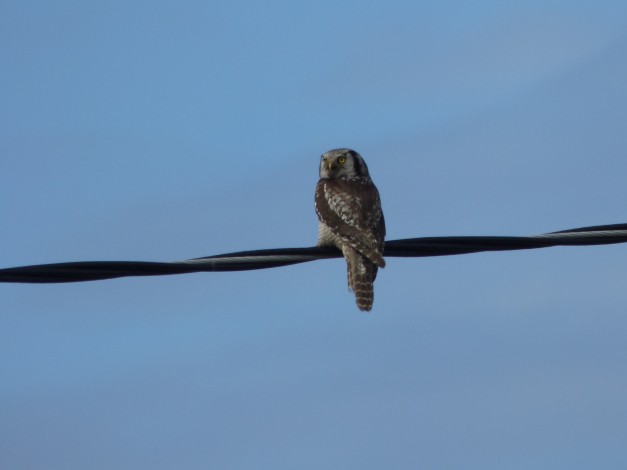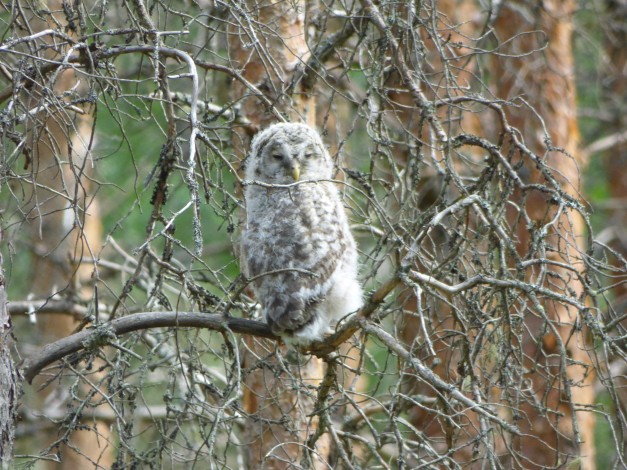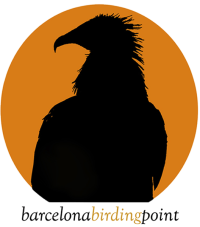Finland & Finnmark Birding Tour 2018 Trip Report
Dates: 11th June to 20th June, 2018
Tour participants: 4
Day 1. As usual in this tour, all participants assembled at Helsinki Airport for an afternoon flight to Ivalo. After a quiet flight we landed in Ivalo, deep inside Arctic Finland late in the afternoon and headed directly to our accommodation in a cold and rainy weather. After dinner we went for short walk around and connected with some common birds. Here we got our firsts Yellowhammers singing but also Fieldfares and Redwings. A nearby lake offered also good views on Tufted Ducks and a pair of Goldeneyes.
Day 2. We wake up again in a cold, wet morning with only 4ºC. An early start was mandatory to catch up with some of the key species we were looking for during our techinically first day of the tour. After some pre-breakfast in our accommodation we drove some miles South of Ivalo, where a patch of mature forest host some of the main targets in the tour. We left the highway and started exploring the canopies in search of some birds. Everything was really quiet as a slim rain was falling down. We drove some miles, checking some corners with little result but, at one point of the lane we stop the van as one wonderful female Capercaillie was standing up by the lane, barely 10 metres away of the van and totally in the out! We enjoyed very much of that view. We slowly went a bit back, and as not raining any more we could enjoy with the view of the bird really long. The wonderful bird was studying as for a pair of minutes and then slowly started to move into the forest walking on a bare slope. We still had time for improve the view and the shots as the bird stoped a last time to take a last glance on us before disappearing in the vegetation.

Absolutely amazed of having a Capercaillie as one of the first birds of the trip we kept driving up. Here there is a moment when the forest become really mature, having good old trees around. We parked the car and walked around. Bramblings were singing around and a Common Snipe was flying over. Here, we had also some common birds in this kind of habitat including Tree Pipits, Redwings, Willow Warblers and Common Cuckoo flying over. Bramblings were especially active that morning and several males were singing, flying around and dispalyinhg. We just walked a bit along a path slightly going up the slope. Here we had a bird flying away from us, and as briefly stopped, we discovered a wondeful Ring Ouzel that unfortunately almost inmediatly took off and disappeared inside the forest. From the top of the slope we could scan around and from there we got a male Capercaillie standing up in the middle of the path, some 400 metres away from us! What a wonderful view. Unfortunately the bird was fast in disappear and, despite our efforts, we could not relocate that massive grouse. We kept scanning and got lucky since 3 Siberian Jays came out of the forest and gave us wonderful views while feeding on the top of the trees and moving aroung in the canopies. Few metres away, a wonderful Siberian Tit was calling so we took advantage and enjoy wonderful views.

After such a wonderful start we decided to drive a bit along the tracks. It was still cold and cloudy but with no rain for long. Along the driving we got some Green Sandpipers singing here and a pair of Greenshanks. Common Snipes look like being everywhere. After some kilometers we enjoyed another wonderful moment as one male Black Grouse was standing inside the forest, 20 metres away from the minibus! We again enjoyed walk-away views on the bird, having different angles on it so everybody could enjoy the bird. Suddenly, a second bird appeared from a small ditch in the forest, feeding on the berries. This second male had not see us at all and when saw us flew us, closely followed by the first bird. Wonderful! Black Grouse is a quite difficult bird to get in June and we were not expecting to see this species along the tour at all! We still had a pair of stops along the track, having a total of 5 more Siberian Tits along this way!!

Happy after this wonderful start we went for coofee before driving South for some more birding. After some nice and warm coffee we started our transfer South towards Oulu, but before we still had a short stop not far away from the highway, since one pair of Northern Hawk Owl had been seen around. We did a short walk around, doing an accurate scanning. Northern Hawk Owls use to stop quite in the out, many times on tree tops, but they also can be hard to find out. After about half an hour of scanning we got nothing and we were really about to withdraw when one of the tour participants found a wonderful young Northern Hawk Owl standing up in the middle of one garden. It was a quite grow up chick, already capable to do a short flight… We all have wonderful views on the bird. Some minutes later we managed to find a second chick, deep inside the garden. Suddenly a Great Spotted Woodpecker called around and the shape of an adult Northern Haw Owl passed above us to stop in a close wire, allowing really good views. We all enjoyed very much of this moment. The adult was really garding the area so we went a bit away to make them feel better. After some minutes the adult came closer to the garden and stopped in a tree top nearby. It was moment for us to leave and keep moving South.
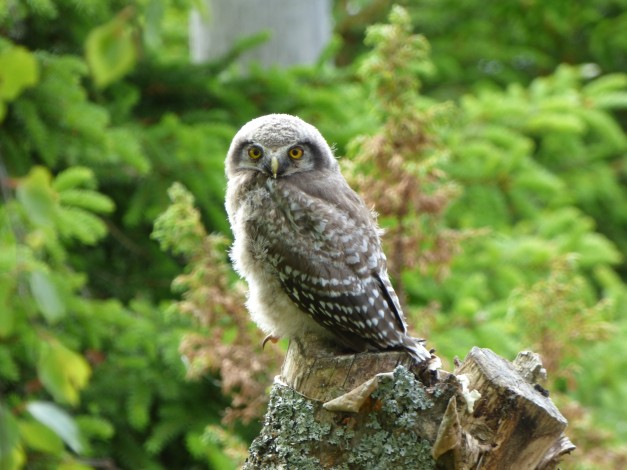
Glad with the wonderful morning we had all enjoyed, the transfer South was really pleasant. We did some stops in the way, anyway. The first exploration of he tour in a typical wader nesting place was quite productive. We got (distant) views on 2 Common Cranes, some summer plomaged European Golden Plovers, Reed Buntings singing, several Meadow Pipits and 2 Whooper Swans. The second stop was a bit less productive: 1 Western Osprey flying around plus a really interesting Little Bunting singing in the low rank vegetation! We scanned hard trying to find this really bird but unfortunately we never found it… The transfer also produced some typical roadside birds in the way of 1 White-tailed Eagle, Goldeneyes and Red-breasted Mergansers.
Once in our accommodation we had a good rest before having dinner. After dinner we took advantage of the wonderful light outside so went for a short walk. In the fields, some Rooks were moving here and there, being this species quite scarce in Finland. Skylarks and Reed Buntings were singing and we enjoyed of wonderful views in a pair of Pied Flycatchers nesting inmediatly around the parking place. 1 Common Rosefinch was also singing from the top of a tree, but didn’t allow any photo… We went then for a short walk in a close marsh. There we had wonderful views on some male Ruff showing stunning summer plomages, moving in the tall grass. Common Snipes were displaying all around and a Lesser Whitethroat showed briefly inside a bush.
A short walk introduced us until a platform. In front of us had a wonderful view on Liminganlahti estuary. Flocks of Pintails were in the marshes. Wigeons, Eurasian Teals and Whooper Swans were all common. More distant, a huge flock of 300+ Common Cranes were roosting in the marshy area. Little Gulls were flying over in what was a wonderful scene to be admired! Several waders were moving around. Wood Sandpipers, Green Sandpipers and Eurasian Curlews were spotted. Also a wonderful flock of 20+ Spotted Redshanks in wonderful summer plomage! This is species is the one which is leaving before the nesting areas, located more to the North. The flock we saw were probably males already in their way South! Back in the marshes, a proper scanning revealed a Short-eared Owl flying over, being “joined” by 2 Hooded Crows.

Happy after such a wonderful end of the day we just came back to our accommodation for a good rest.
Day 3. We wake up with in a wonderful sunny morning and went off our accommodation for an early morning birding. Our first goal was to explore a pair of lagoons offering potential good birds. In the short transfer to the lagoons we had some nice birds. 100+ Common Cranes were feeding in a farmland along with Northern Lapwings and Eurasian Curlews. In the highway South of Oulu we got a wonderful male Pallid Harrier flying over, something quite unexpected and celebrated.

Our first stop was in a lagoon. A fast scanning produced Common Scoter along with Goldeneyes. Distant Whooper Swans were also noticed. A second scanning produced good views on 4 wonderful Velvet Scoters and also the only 2 Goldcrests of the trip in the trees around the lagoon. Our second stop was also quite successful. Parked by a busy road we searched in a pair of ponds. We didn’t wait long since 1 Terek’s Sandpiper flew inmediatly in front of us producing really nice views! After a little while, the bird went to the opposite side of the lagoon but then we got 2 more Terek’s close enough to enjoy good views and some more shots! This was absolutely great since Terek’s Sandpiper has become really rare in Finland with only a handful of pairs around Oulu! Around the place of the Terek’s we got other nice birds including Common Whitethroat and Common Rosefinch.

Satisfied for this rather unexpected success we scanned a bit around and got some Sedge Warblers in a nearby reedbed. The water body and shores around were having Common Ringed Plover, Wood Sandpiper, Common Redshank and Eurasian Teals. Before going to forest, we still had some time check the estuary itself, where we got several Little Gulls moving, a distant Greylag Geese, Western Osprey, and the very first Arctic Tern of the tour was delighting us with good views.
After such a great start of the day we moved to check for some owls. Not far away from Oulu there are several locations for many of the species living in the country. We first went to a place for Eurasian Pygmy Owl, located on a mature spruce patch. After few scanning we got absolutely amazing views on the bird as it was perched only three metres away from us. We enjoy it long views on this wonderful tiny owl and we left the place without disturbing it!
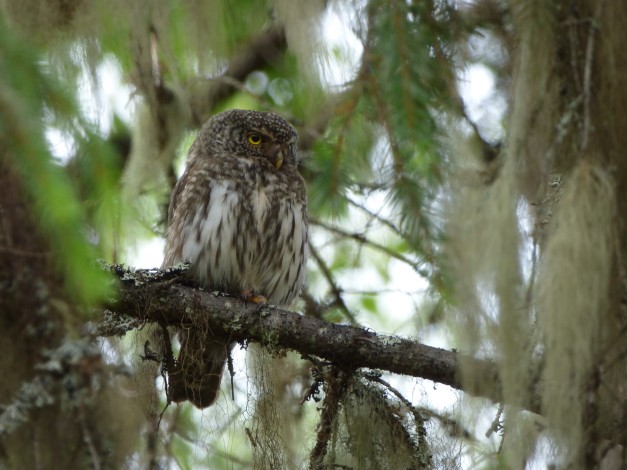
We then went to check a place for Ural Owl but we had no luck and the nest was empty…No signal at all on this bird at the location. But around there it was also a nest of Great Grey Owl so went to try this bird. In the way, we had 3 Eurasian Woodcocks flying from the lane and 1 Eurasian Nuthatch showing really well as we parked the mini bus. We spend quite a long time looking for the nest this massive arctic owl but we finally got lucky and enjoyed incredible views on the Great Grey Owl lying on the nest. The nest was located in a really low location so we were not expecting to see the bird that close!! We still had some time looking for the pair of the Great Grey Owl as it had to be roosting nearby but despite our efforts we could not find it at all.
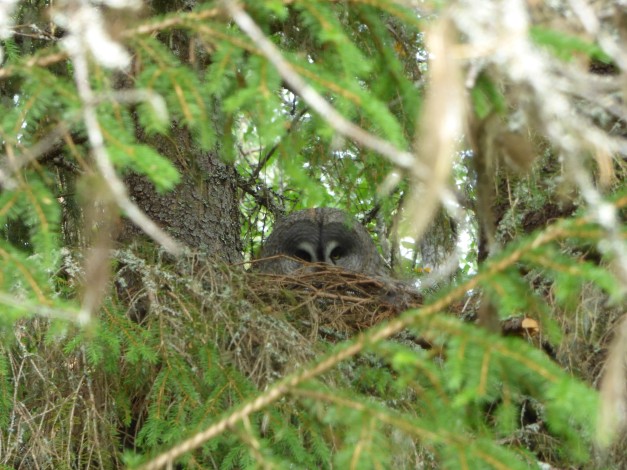
After a short stop to have some coffee we kept going our route. A nearby place was having a pair of nest boxes for Tengmalm’s Owl so we went to check. The first nest box was damaged so could not host anything. Second nest box was apparently in good conditions but looked like having no owls inside. We neither saw any signal of activity below the nest box. We started the way back to the van when a several calls of Tits and Blackbirds came from the direction of the nest box. We fastly went to check and found a wonderful Tengmalm’s Owl stiking its head out of the nest box! What a wonderful sight, especially after thinking we were going to miss this bird!!! We had good views on the bird for a pair of minutes, when it went down in the whole and disappear. Happy after another wonderful sight we came back to mini bus.
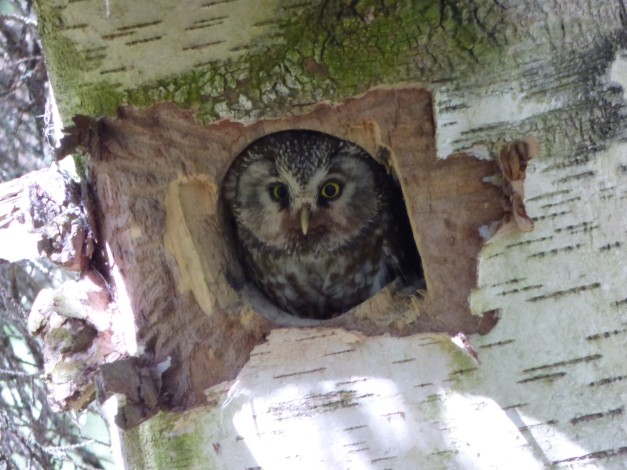
In the way we had good views on 2 Spotted Flycatchers and had 2 Song Thrushes flying as well as Eurasian Treecreeper. In a nearby field, a Common Kestrel was hunting. We still had plenty of time so we went on driving for a way until a new place where to try Ural Owl. And this time we got lucky.
A Scottish Pine forest surrounded by farmlands is hosting a nest box. In our short walk until the area Yellowhammers and Tree Pipits were singing all around. Eurasian Jay was also seen, being the only was sight of the bird in the tour! Once in the place, we proceed with a proper scanning around. We got 1 Eurasian Treecreeper but little more out of that. About to leave the area, we did a last, desperate scanning and then we got a wonderful adult Ural Owl standing deep inside the forest!
The massive owl was a wonderful view inside the deep canopy and could enjoy the bird long. We had time to scan around and actually found a grown chick of Ural Owl closer to us, inside an area of young trees. This was already wonderful and really celebrated in the group! After enjoying the birds a good while we went back to the minibus to keep going on.
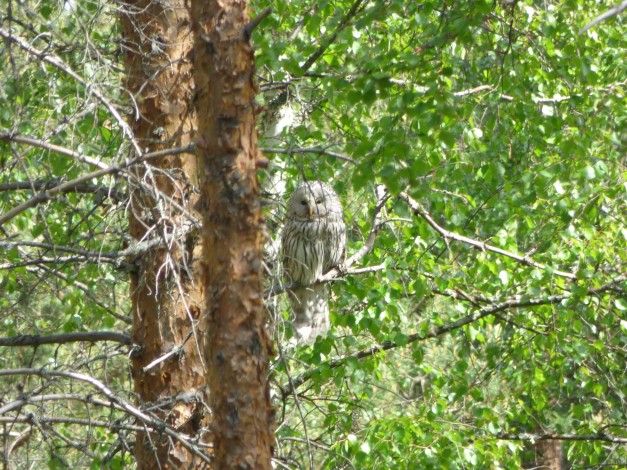
We had good views on a passing Pallid Harrier in the early morning while driving towards Oulu so we decided to go back to that area and scan for eventually have better views. In the way, we got excellent views on Black-tailed Godwits in one of the very few nesting places in Finland! Once in the place we scanned the large fields and we fastly got noto ne but 2 males Pallid Harriers in diferent areas of the field! One of the birds moved our way and we had chances for some nice shots, despite the wind! 2 Short-eared Owls were also hunting in the area and were a nice add to our day list (5 owls in a day, not bad at all!).


After this wonderful day we just had a 90 minutes transfer to Kuusamo. In the way we had first views on Black-throated Divers in splendid summer plomage. Once where arrived to the hotel we went for a good dinner and a long rest.
Day 3. This day we were concentrated around Kuusamo, where a number of key species can be seen. We had a really early start to look for Grouses. We drove around expecting to connect with some of them but we were unlucky that morning and we could not find any. We did a number of stops and enoyed good views in both Smew and Surf Scoter. Goldeneyes and Tufted Ducks were widespread. While enjoying one male Surf Scoter we got 2 Siberian Jays moving really close to our minibus and a pair of flocks of Common Crossbills feeding around and the common view of Mealy Redpolls flying around.
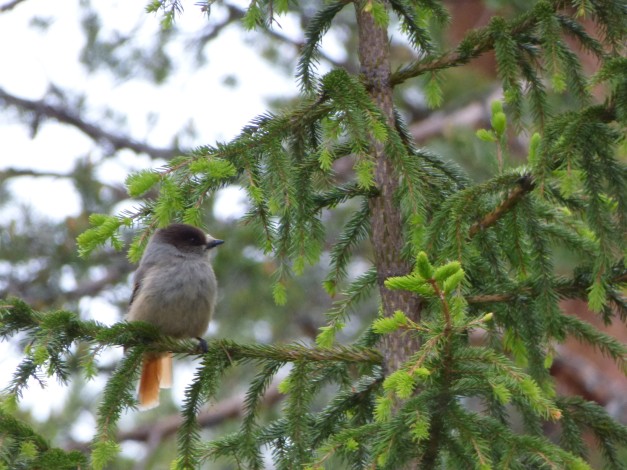
We then went to explore Parikaala, one of the best places where to try Red-flanked Bluetail. Just arrived to the parking place we got a good views on a small flock of Parrot Crossbills moving up in the canopies. A walk around produced good views on Tree Pipits as well as the only one European Crested Tit of the trip! In our walk we were joined by the distant call of a Black-throated Diver and the display flights of Wood Sandpipers. After some walk we started looking for Hazel Grouses in one of their favourite corners. We carefully scanned around hoping to see the bird grazing or resting on a tree branch, No results until the clear call of a male came to us. It was not specially far away. More scan. Little walk. The bird was calling a second time. We waited long in the place, hoping for a movement to come out from the canopie but, unfortunately, it never hapenned.
Few minutes later a different song came to us. 1 Red-flanked Bluetail was singing around. We scanned the tree tops around and got distant views on males singing from a tree top! We tried to get closer but far before we arrived the bird was down again….
We kept going up and enjoyed really good views in a pair of Bohemian Waxbills feeding on berries in a small tree. 1 Scandinavian Willow Tit passed by, calling, and god good but brief views on the bird. But then everything went fast because 1 Tree-toed Woodpecker was calling in the distance. We gather until the area where the bird was calling and scanned around. Nothing. Moved to small elevation giving us a good view from where to scan the area and then we got the bird in a tree and inmediatly took off flying to out left, allowing really good views in flight! The bird went away quite far so we walked dow and track the area. Its call came out several times but we never could reconnect with the bird…
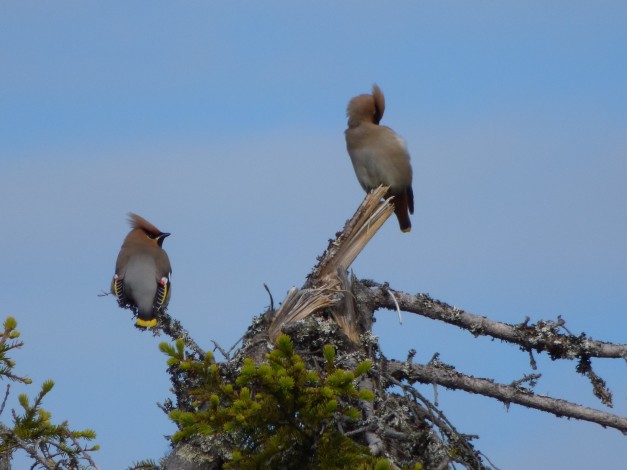
We then decided to try again the corner where the Red-flanked Bluetail was singing and this time we were lucky as the bird showed up really well, singing out from the top of a tree. This area is normally having different males (we counted no less than 6 in 2017) but this year it appeared to be only one… Happy after this successful views we went the way back to the car. Around the parking place the flock of Parrot Crossbills were still visible alowing good views.

After this productive morning we went for a good and early lunch and some rest. The afternoon came soon and before going for dinner we went for some birding not far from our accommodation. We were to enjoy some water birds in one of the many lakes near Kuusamo. Fieldfares, Hooded Crows and Redwings were all common views. The short track to the platform was having a close Little Bunting singing around and we were soon enjoying good views on this scarce bird!

From the platform we could enjoy Whooper Swans but also close views on Black-throated Divers, Goldeneyes and displaying Common Snipes.
Day 4. This day we had a really chilly and wet morning. Went to a different spruce area hoping for more Red-flanked Bluetails to be but, unfortunably was really windy. We only got some Bohemian Waxbills and 1 Scandinavian Willow Tit. Still, we decided to spend some more time by the road hoping for some activity. Song Thrush was singing and a Common Crossbills. A single Willow Warbler was singing in the canopy. Weather was stil cold and unfriendly but then we did lucky as suddenly 1 Three-toed Woodpecker passed by our side, allowing good views in flight and going inside the dense canopies! We scouted all the area around but the windy conditions were not the best to find anything on the trees. After some more time in this area we decide to leave for some warm coffee!
After a good warm coffee we just started moving North but stopping in a nice lake inmediatly North of Kuusamo. Once more we got excellent views on Whooper Swans, with Greenshanks and Reed Bunting singing around. 2 White-tailed Eagles were seen flying around and a small flock of Common Terns were feeding in the lake. Goldeneyes, Red-breasted Merganser and Tufted Ducks were all seen but the bird that was really celebrated was one wonderful Red-necked Grebe in nesting plomage, showing really well by the opposite shore of the lake.
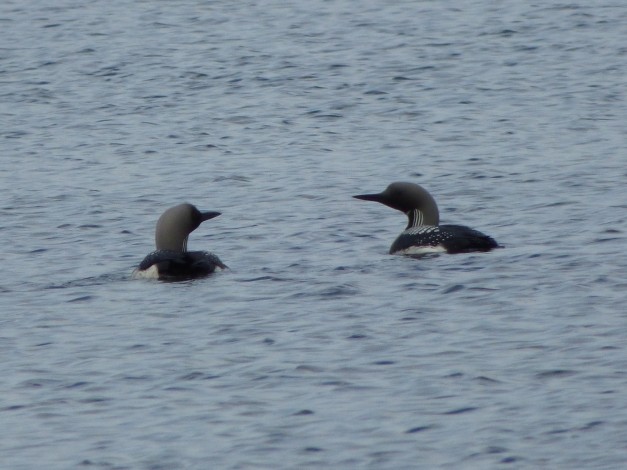
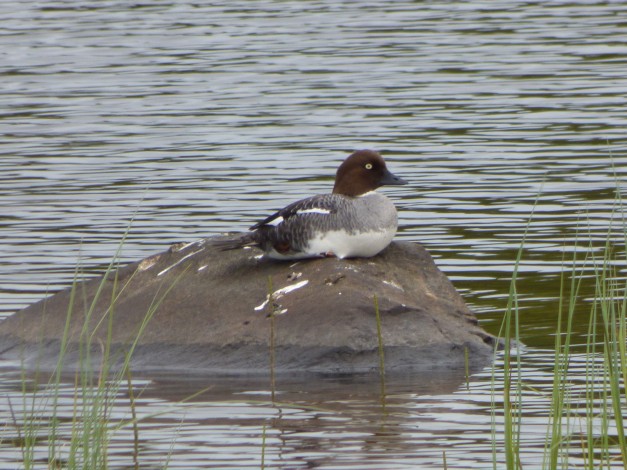
After this great stop we kept driving North for some 90 minutes, until we crossed a patch of wonderful ancient spruce forest. This is also a good place were to stop so we did so to take a look. Bramblings and Redwings were all around along with Tree Pipits. A pair of Bohemian Waxwings flew over and 1 Common Cuckoo was heard singing nearby. Many Willow Warblers were singing around, some of them really road by road. In the low vegetation in the left side of the road we got something bigger moving and we were grateful to see 3 Pine Grosbeaks feeding on berries few inches from the ground. The birds came down to the road picking on the dart. The birds allowed us to come closer and we got excellent views in on them three bu thre group really enjoyed the male, showing really nice colours.
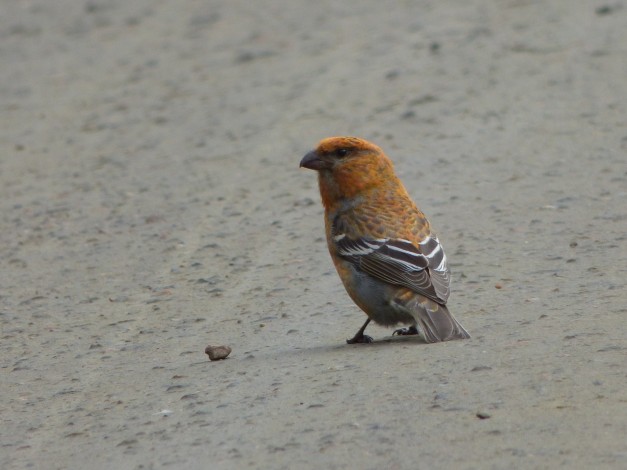
Back to the car we kept moving and scanning. Some more miles North we had to stop again, this time because of a small flock of Parrot Crossbills feeding also on the dart! After these happy findings we kept driving North for a pair of hours to arrive back to Ivalo, where we sleeping some miles of the town.
Day 5. This day we went to explore some bog areas for waders West of Ivalo. Here large areas are occupied by shallow water marshes. The dense vegetation around hosts several interesting species. We arrived early morning and scan around. Some really nice Wood Sandpipers were singing and displaying around and the sound o the displaying Common Snipes were constant. Some Mealy Redpolls passed by, calling. Then a small bird flew from the grass around to end a close tree and we found ourselves enjoying the very first Red-throated Pipit of the trip. The bird allowed good views, despite being a bit inside a small tree. Happy after this good start we kept scanning and found a Jack Snipe displaying in the sky, passin over us over and over and allowing excellent views. We did a small short walk in the marshy area and easily got 1 Red-spotted Bluethroat running in front of us. After some metres of run the bird just turn so everybody in the group had excellent views.
We still had some time around with the wonderful Jack Snipe still flying above us, displaying and diving into the dense vegetation. 2 Greenshanks were also singing in the bog and 1 European Golden Plover was also noted.
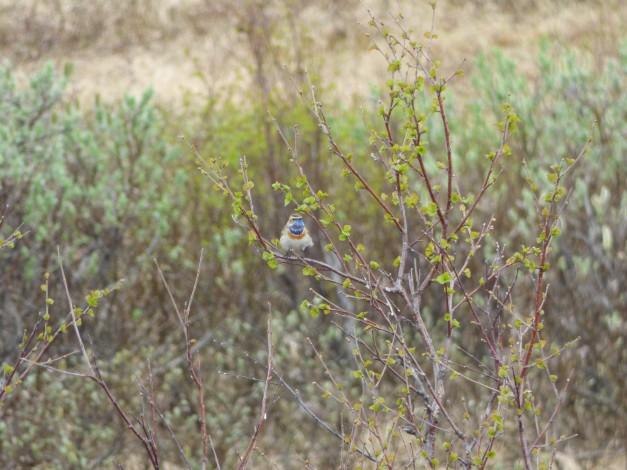
After such a good start for the day we went for a short walk in a nearby hill. Up in this hills the tundra dominates the landscape and it is possible to find really exciting species.
The short walk was dominated by dozens of Meadow Pipits singing and showing in the short grass lands. European Golden Plovers looked like being everywhere and 1 Eurasian Whimbrel was noted close to a small mountain pass.
From here we got an impressive view on this area of Scandinavian Alps, some sumits still with snow in the distance, while the Eastern part of the view was blocked by the rocky scarpment of a nearby peak. The scan around the area produced more European Golden Plovers and 1 Eurasian Dotterel showing really well in the Western part of the meadow. We tried to approach when something really floating passed over us: 1 Long-tailed Skua!
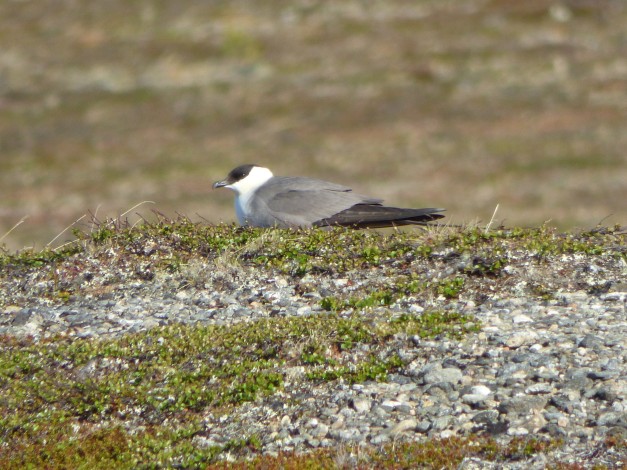
The bird just flew over to stop in some 100 metres away, in a tiny hill stiking up from the grassy plain. We had incredible views on the birds when a second individual came from the same side and both birds went to the sky for a full dispaly of flights, dives and
chasing. After this incredible sight we came back to the Dotterel. If was not there any more. A bit of scan was necessary to relocate the bird, but we all got it again in the bins, now definately more far away. We tried to approach but unfortunately the bird flew along with 2 European Golden Plover and we lost track of them.
Still having some time before lunch we decided to go a bit closer of the rocky scarpment, expecting species related with this kind of landscapes. We scanned all around with little feedback and were about to leave when 1 Snow Bunting appeared from somewhere! The bird just landed close to us, allowing some nice views while the bird was feeding.
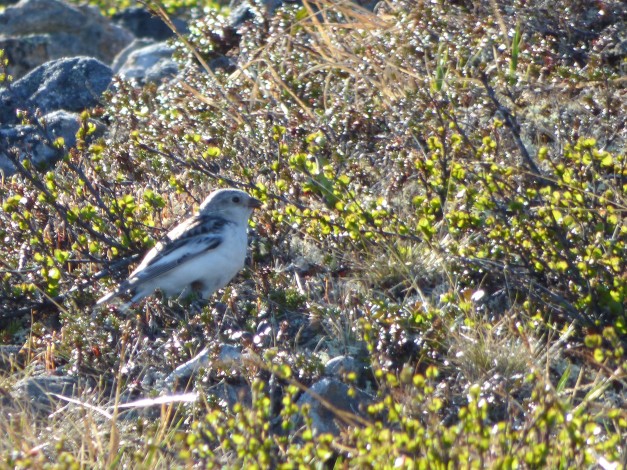
Happy after this nice morning, we just went down for a nice lunch. But prior lunch we had a stop in a stop lagoo, where a nice flock of 17 Red-necked Phalaropes was feeding. Wonderful, some of them beautiful females! Along with them some male Ruffs but also Eurasian Teal. Bluethroats were singing around, including a brief view on a male. Here we also got a small flock of Arctic Terns in their way to nesting sites. Already really close!
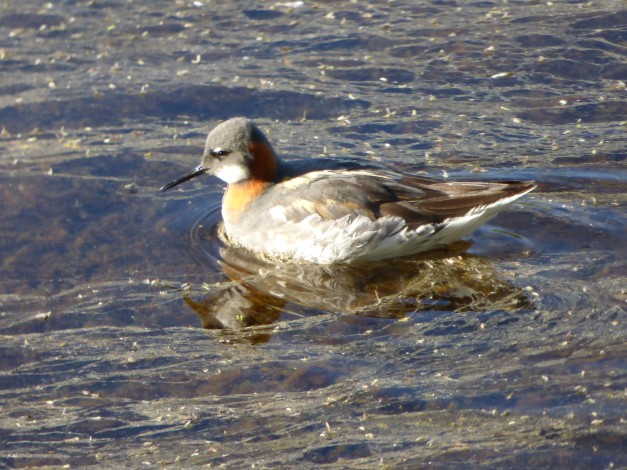
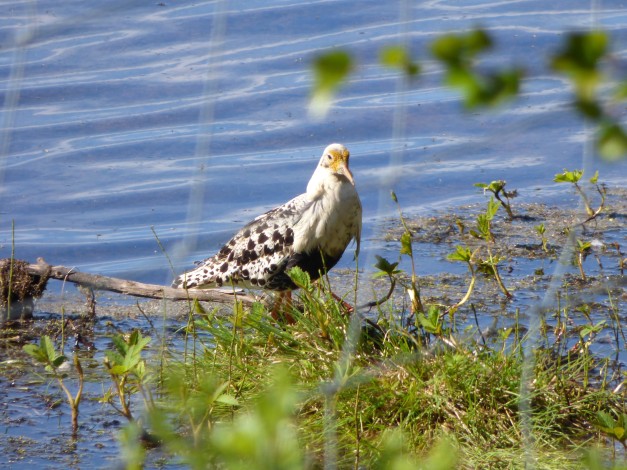
After lunch we did a pair of stops in different ponds and bog but we did not have any other result out of the firsts Arctic Redpolls of the trip! 2 birds flying and perched low in a small tree that gave us really good views.
The rest of the afternoon we just took advantage of the feeders in our accommodation to enjoy excellent views on Pine Grosbeaks. The feeders also attrack large numbers of Mealy Redpolls and some Bramblings. The feeders also attrack Pied Flycatcher, Greenfinches, Common Redstart and Red Squirrels.
Day 6. Early morning once again to go North, into Norway. Still, before crossing the border we had a good stop along the way. A extensive area of bog is having small populations of Broad-billed Sandpiper. Here we had Wood Sandpipers, Ruffs, Golden Plovers and Common Snipe displaying. 2 obliging Siberian Tits were also a good addition along with Common Waxbills and distant Great Grey Shrike and 1 Black Grouse flying across. Unfortunately we had no contacts on the main target there…
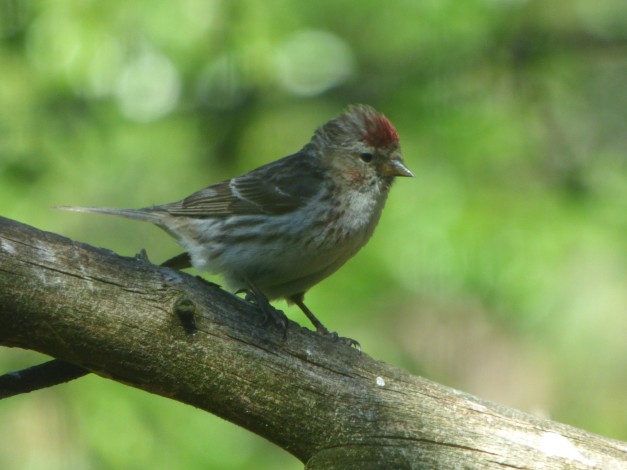
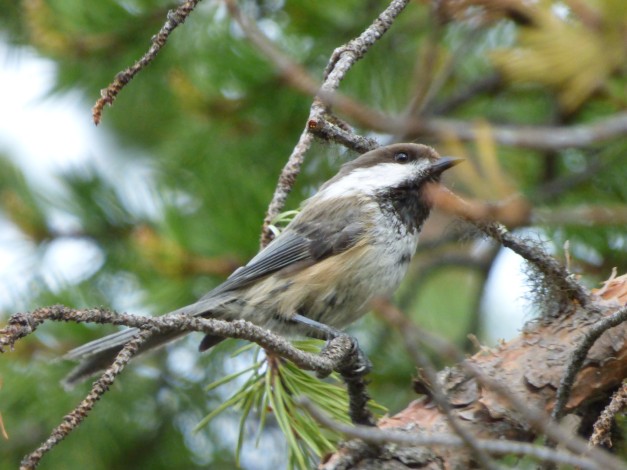
Along the road we had some stops: Common Crossbills (always worth checking) but also Rough-legged Buzzards and Tufted Ducks were seen.
Once in Varanger we did a short stop in Nesseby. Here we had excellent views on a flock of Red-necked Phalaropes and some Ruffs. Common Ringed Plover, Bar-tailed Godwit and Dunlin were also nice addings to the trip list. Beyond Nesseby flocks of Red-breasted Merganser and Goosanders were seen on the fjord. Also large flocks of Common Scoters (200+) along side Surf Scoters.
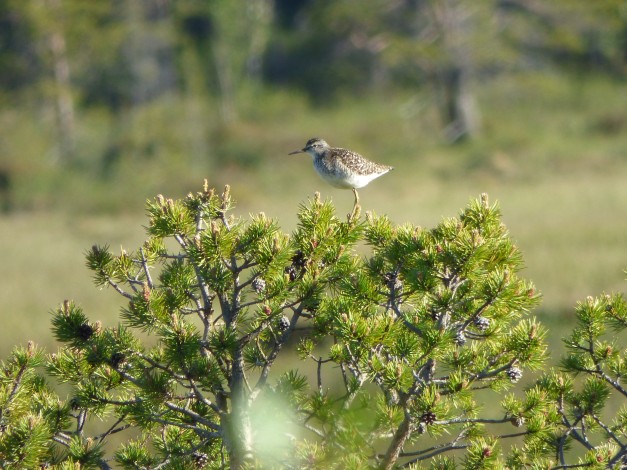
Kittiwakes were already a common view, with flocks of hundreds of them moving along the coast, along with Herring, Great Black-backed & Common Gulls. Along the road we had firsts views on nesting Parasitic Skuas, sometimes allowing really close views! Along the shore, White-tailed Eagles were a common views, sometimes alone but sometimes congregated in small flocks.
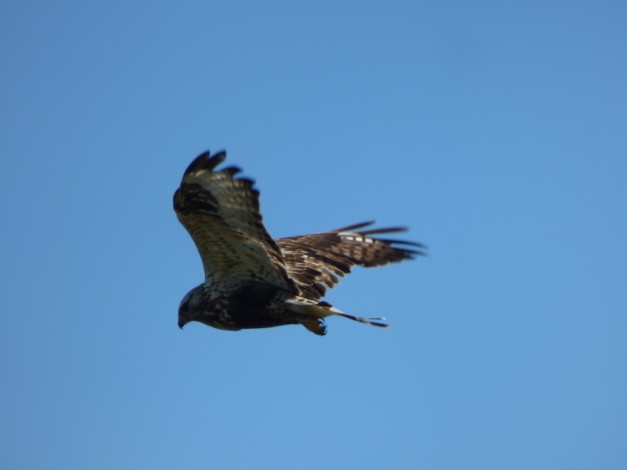
Our way to Vadso produced a nice surprise in the way of 2 Tundra Bean Geese resting by the road! This was a rather unexpected finding! Oystercatchers & Common Eiders were already everywhere, even along the acess bridge to Vadso. A short walk in the area produced wonderful views on Common Redshank singing but also lovely views on Arctic Redpolls and Red-throated Pipit feeding around. Some elusive male Ruffs were also spotted in the tall grass, althought they were reluctant to show properly. The small lagoon was having some Red-necked Phalaropes and the place produced good views in the only one Pomarine Skua of the trip!


Our attention was concentrated in trying to find Steller’s Eider (had one around in 2017) but no luck this time.
The final drive to Vardo still produced a Short-eared Owl by the road so another stop had to be made. Once arrived to our accommodation we got a good rest before dinner. After dinner, we still had 1 hour to enjoy the midnight light. A short drive was done and got excellent views on Little Stint, Temminck’s Stint, Horned Larks, Red-throated Pipits, Parasitic Skuas and a wonderful male Lapland Bunting!!! What an amazing end for the day!
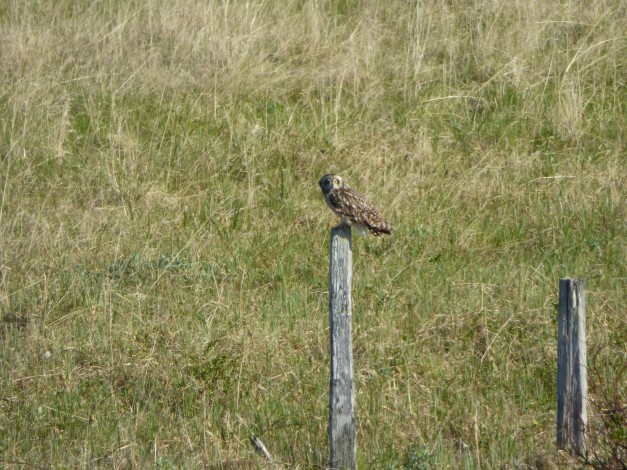

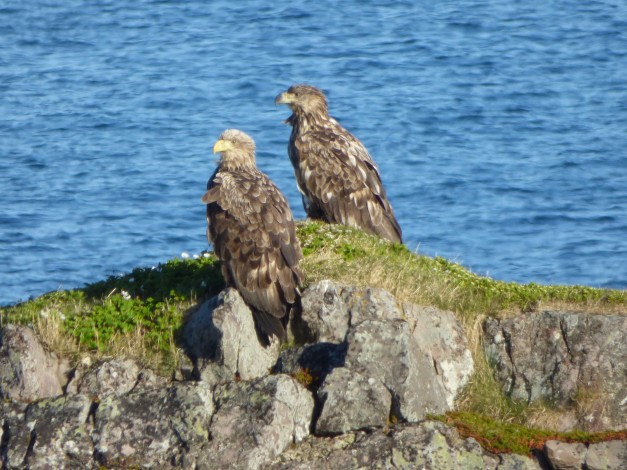
Day 7. This day we didn’t go for a really early start but have some time to recover. Our boat to Hornoya was our first appointment so after breakfast we went to the dek. Here we had a good scan around while Arctic Terns were flying around us. Black Guillemots were also a good attraction, but being a bit elusive this time. A second year Glaucous Gull was found roosting in one of the buildings at the other side of the harbour, providing with good views in the scope.
Once in the Arctic Ocean we were soon enjoying with thousands and thousands of Guillemots were carpeting the Ocean. Razorbills were also numerous and Puffins were also moving around in good numbers. As approaching the island, the noise and the smell becomes more intense. Here, 250.000+ are nesting in a huge colony. Atlantic Shags were also all along the shore, always in the big rocks protecting the island. Even before arriving to the island we got some Brunnich’s Guillemots showing really well along with other auks.
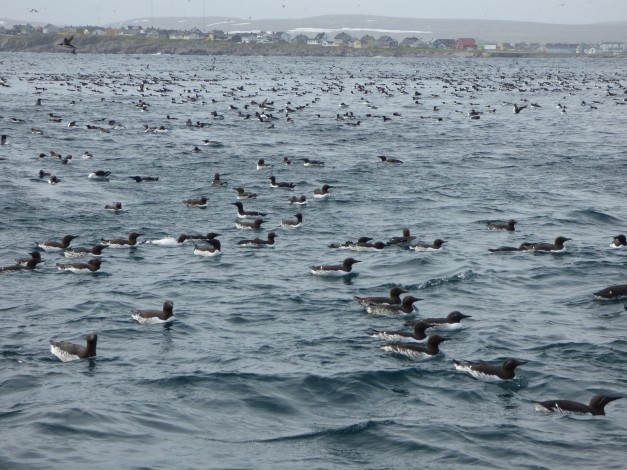
Once in the cliffs, Brunnich’s Guillemots tend to nest quite high so it makes more difficult to have excellent views on the birds. Still, with a bit of patience, the whole group enjoyed great views on them. A walk around easily produce ridiculous views on Atlantic Puffins. Several Parasitic Skuas were flying around, patrolling in search of a easy prey. Along with them and the hundreds of auks in the sky we also got 1 Gyr Falcon patrolling above the colony of Herring Gulls. Gulls were not happy about the presence of the predator and they made sure the Falcon to notice about! We had a good sight and the bird disappeared in the massive movement of birds in the sky. As the group was a bit disperse taking photos, not everybody enjoyed the Falcon. We hoped for the bird to reappear, but never happened. We kept enjoying the magnificient concentration of birds and also picked up really good views on Rock Pipit (littoralis) and really close views on Black Guillemot.

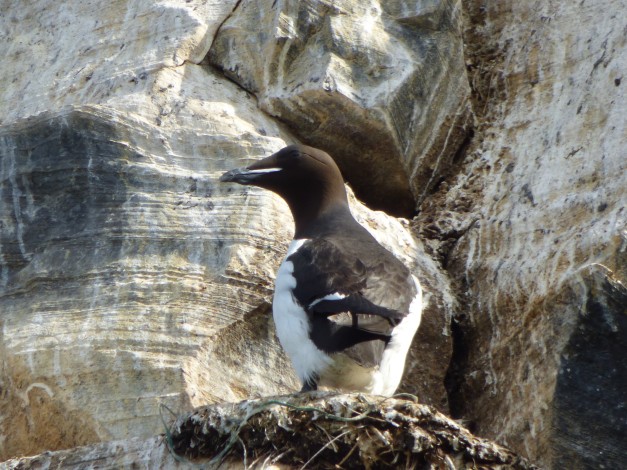
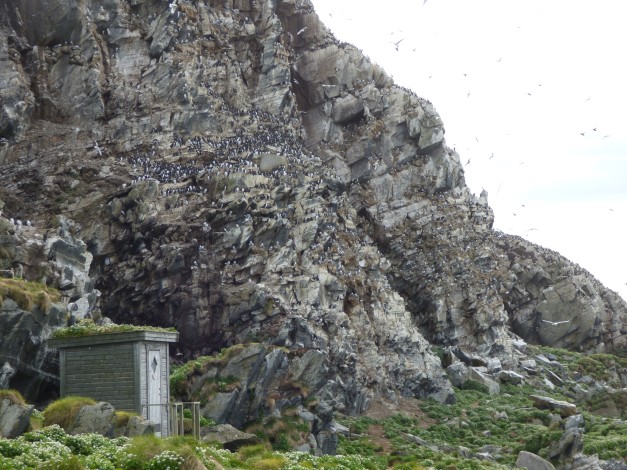

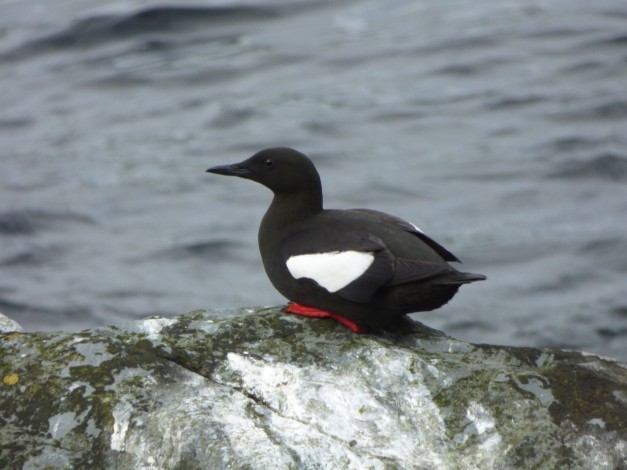

Once back in Vardo we went for lunch. In the afternoon we went along the coast, expecting some nices species. We again got nice views on Lapland Buntings, Temminck’s & Little Stints, Shore Larks & Whooper Swans in the tundra. In the coast, the firsts flocks of Long-tailed Ducks were seen along with Common Eiders and Red-throated Divers.
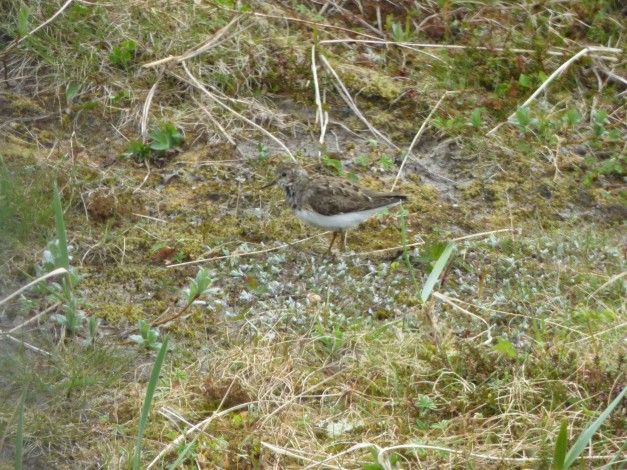

Day 8. This day we drove even more North to explore the Northernmost fjords in Varanger. Along the way we stopped several times. Roadside birding in this part of the world can inlcude Long-tailed Skuas but also Rough-legged Buzzard, Scaup, Long-tailed Duck, Red-throated Diver and others.

A selected stop in the higher plateau produced 3 Snow Buntings along with Dotterel, Tundra Bean Goose, Long-tailed Duck, Lapland Bunting, Golden Plover and Eurasian Curlew. A proper scan around allowed us to find the first Rock Ptarmigan of the trip! A short drive and we were having really close views on the bird, still showing a good number of white feathers.
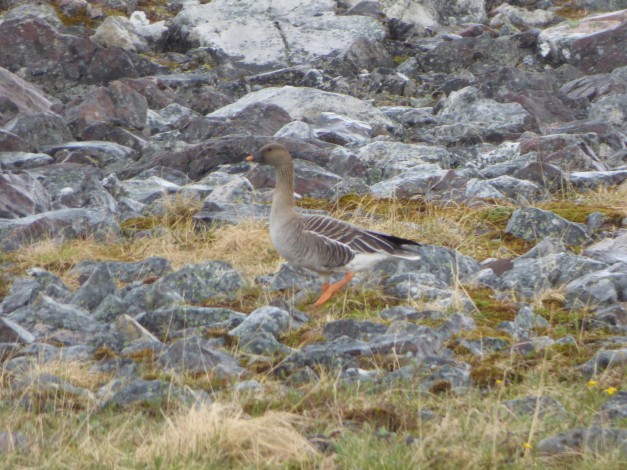
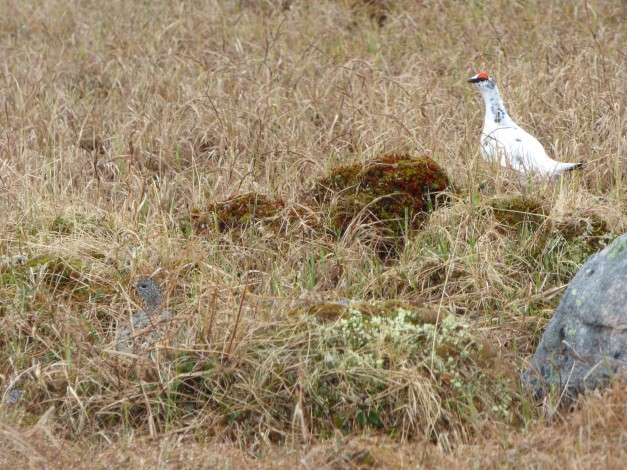
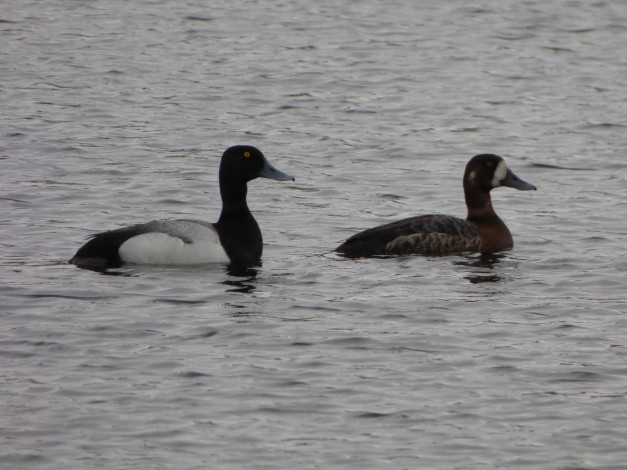
During the afternoon we arrived to coast. Here we had more scanning, this time in the shore. Several Common Eiders were roosting and feeding and we were lucky enough to find 1 female Steller’s Eider feeding along with them! We approached the group and everybody had excellent views on them despite the misty ambient!

After enjoying long this lovely duck we just went to our accommodation for some rest and good dinner.
Day 9. This day we spent the morning in exploring a patch of coast producing good birding most of the times. But before we had a second visit to the Steller’s Eider, being now really more far away than the afternoon before. We also had another stop in the way, this time to explore a nice landscape for grouses. And we were right in our thoughts since we had 2 Willow Grouses flying around, one of them stopping for some seconds on a rock before disappearing in the grass! A brief view, but worth it! We scanned around trying to relocate them, but was impossible.

Kept going our way. Once in the patch of coast, the area was totally foggy. We just kept driving until the closest village, where we had a coffee. The fog was not going to disappear so we moved to shore to scan for birds. A small corner looked like interesting and we cheeked all Eiders around, and we were lucky since a female King Eider was among them! This was one of the most celebrated bird of the tour, along with Steller’s Eider!! We had a good time enjoying this bird, most of the time sleeping but sometimes active and moving along with 2 Long-tailed Ducks and Common Eiders.
As it was foggy we started drive back until we found a window without fog. Stop and check. Beside the car, 2 Twites flew off up to the cliffs! In the sea, we fastly saw several Northern Fulmars moving along the coast. About 30% of them were of the beautiful blue form. There were still some fog. We did some scouting looking for Yellow-billed Divers, but never found them… and only got Black-throated Divers. Instead had several flocks of Common Eiders and Long-tailed Ducks. Also some Manx Shearwaters moving up and down. One of the tour participants found 1 Fin Whale moving close to coast. Wonderful spot!
After some more scanning in a pair of Windows in the fog we just drove South for a final overnight near Ivalo, where we arrived for some rest and a good dinner.
Day 10. Final morning of the trip and still some time to check for some birds. It was rainy and really chilly but went to a corner offering good chances for buntings. We waited under the rain but nothing happened for long. We were really about to leave when, suddenly, a bird came out of the vegetation to stop in a nearby tree and started singing: was 1 Rustic Bunting!
Light was poor and we were all wet and cold but this very last minute sight was absolutely worth it!!!
After this we just drove to the airport to take our flight home. Never tired of birding in Lapland. Join us!!!


